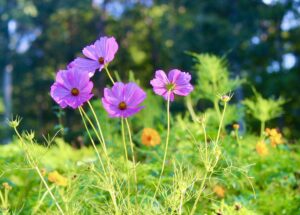By Jocelyn Smith
In October, the Wildflower Bunch was excited to unveil A Survey in Progress “Plants of Big Canoe,” one of the club’s many initiatives this year led by our President B. Marr. Thanks to Marr and her wildflower enthusiast volunteers, WFB began an ongoing project to discover and catalog many of the plants found in Big Canoe for all WFB garden members to enjoy and reference.
Over the past year, a group of wildflower enthusiasts have been working to identify and photograph all of the plants found in the Big Canoe public areas. Access to the full survey can be found on the website at https://wildflowerbunch.com/ where members can enter with a secure password.
Before beginning the survey presentation, Marr announced several club donations that were given to multiple organizations and groups. Due to the success of events this year, WFB was able to give $1,500 to the Big Canoe Trails Committee. We appreciate all of the efforts and hard work the trails volunteers do to keep our community a natural and safe environment to explore and enjoy. In addition, $1,250 of “real nature spirit” books were donated to the Big Canoe library and two elementary schools in memory of Cheryl Jones, WFB’s past President who passed away unexpectedly this year.
Marr began her presentation by explaining that this special survey began as a desire by Wildflower enthusiasts to catalog plants located in Big Canoe public areas within the gates as well as Eagle’s Rest Park and Terraces. This was a renewed effort that began in 2021 and was rekindled in February 2023. Thousands of steps and many miles of hiking were completed by the volunteers who undertook this love of identifying the many different plant species in our community.
With an undaunting passion for plants, much like The Pollen Path, a Navajo Myths Collection written by Margaret Schevill, the enthusiasts echoed the following verse:
In beauty, I walk:
With beauty before me, I walk.
With beauty behind me, I walk.
With beauty above me, I walk.
With beauty below me, I walk.
With beauty all around me, I walk.
With beauty within me, I walk.
It is finished in beauty.
Marr referenced many resources to accomplish cataloging the plants including:
Picture This – a plant identifier app
https://www.inaturalist.org/wildflower.org
Georgia Native Wildflowers and Plants Facebook group
Georgia Native Plant Society Facebook group
Field Guide to the Wildflowers of Georgia and Surrounding States, Linda G. Chafin
Wildflowers of Atlantic Southeast, Laura Cotterman, Damon Waitt, and Alan Weakley
The selected categories of plants to locate and photograph were many. Marr highlighted a few Species Differentiation plants that are very close relatives but uniquely different from one another. A personal challenge was the identity of the Mountain Mint that has small unique nuances difficult to decipher. Some popular and less difficult plants to find included the Spicebush, Violets, and what she “affectionately” noted, the Big Bloomers. There were many “Spring Showoffs” featured as well as “One Hit Wonders.” Even some Parasitic or partially parasitic plants were found and admired for their unique dependency on other plants to survive. “Summer Hotshots” were a favorite of the audience, as well as milkweeds including non-natives that seem to thrive in our Georgia mountains. Even native weeds with delicate blooms, some as small as a dime and hard to find on the forest floor, were highlighted. Other categories included: Fruits and Berries, and Grasses – good ones and bad ones.
According to the Georgia Exotic Pest Plant Council (EPPC) Invasive Plant list there are three category levels of invasive plants.
An exotic plant that poses serious problems to Georgia’s natural areas by displacing native species.
An exotic plant that is a moderate problem of doing the same but to a lesser degree.
An exotic plant that is a minor problem in Georgia but has been a problem in adjacent states.
There are many invasive plants and Marr cautioned that they can be difficult to eradicate, so she encourages everyone to be careful to not introduce them to our local ecosystem. But she noted that some non-natives can be tolerated and enjoyed like the Butterfly Bush and Autumn Fern, both so popular among Big Canoe gardeners.
As Fall begins to peak, she encourages all of us to take a hike and enjoy the many plants still sprouting before the winter cold takes hold. Continue to enjoy fields of Goldenrod, Aster, Sunflower, Snakerot, White Turtlehead and Strawberry Bush found in our beautiful meadows and forests of Big Canoe.
WFB’s leadership will continue to explore and identify the many plants of our community, so look for updates to the survey, as this ongoing initiative is embraced by even more plant enthusiasts.
WFB reminds all members to mark their calendars for our final get-together on Nov. 15 at Woodbridge Tavern in Jasper for an amazing end-of-the-year celebratory lunch. Members can sign up to attend and select their food of choice via the WFB monthly e-blast.
The Big Canoe Wildflower Bunch is an active club of gardening enthusiasts who meet monthly to enjoy knowledgeable experts speaking on a full range of gardening related topics. In addition, the WFB, hosts and spearheads many special events, projects, luncheons and field trips to sites and businesses that center around gardening throughout the year.
The WFB club’s primary objectives include:
Preserving and protecting the integrity of our natural mountain environment and its native flora
Providing educative programs and experiences
Promoting conservation of our natural resources
Enhancing the beauty of our community
Providing philanthropic gifts to Big Canoe and the area
Membership information can be found on our website https://wildflowerbunch.com/membership. The cost for membership per year is $20 and is open to any Big Canoe resident throughout the year.
COME GROW WITH US and visit our website, https://wildflowerbunch.com/, or Facebook page for real-time updates and future events.
